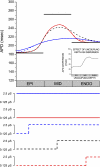Gap junction heterogeneity as mechanism for electrophysiologically distinct properties across the ventricular wall
- PMID: 20035026
- PMCID: PMC2838553
- DOI: 10.1152/ajpheart.00887.2009
Gap junction heterogeneity as mechanism for electrophysiologically distinct properties across the ventricular wall
Abstract
Gap junctions are critical to maintaining synchronized impulse propagation and repolarization. Heterogeneous expression of the principal ventricular gap junction protein connexin43 (Cx43) is associated with action potential duration (APD) dispersion across the anterior ventricular wall. Little is known about Cx43 expression patterns and their disparate impact on regional electrophysiology throughout the heart. We aimed to determine whether the anterior and posterior regions of the heart are electrophysiologically distinct. Multisegment, high-resolution optical mapping was performed in canine wedge preparations harvested separately from the anterior left ventricle (aLV; n = 8) and posterior left ventricle (pLV; n = 8). Transmural APD dispersion was significantly greater on the aLV than the pLV (45 +/- 13 vs. 26 +/- 8.0 ms; P < 0.05). Conduction velocity dispersion was also significantly higher (P < 0.05) across the aLV (39 +/- 7%) than the pLV (16 +/- 3%). Carbenoxolone perfusion significantly enhanced APD and conduction velocity dispersion on the aLV (by 1.53-fold and 1.36-fold, respectively), but not the pLV (by 1.27-fold and 1.2-fold, respectively), and produced a 4.2-fold increase in susceptibility to inducible arrhythmias in the aLV. Confocal immunofluorescence microscopy revealed significantly (P < 0.05) greater transmural dispersion of Cx43 expression on the aLV (44 +/- 10%) compared with the pLV wall (8.3 +/- 0.7%), suggesting that regional expression of Cx43 expression patterns may account for regional electrophysiological differences. Computer simulations affirmed that localized uncoupling at the epicardial-midmyocardial interface is sufficient to produce APD gradients observed on the aLV. These data demonstrate that the aLV and pLV differ importantly with respect to their electrophysiological properties and Cx43 expression patterns. Furthermore, local underexpression of Cx43 is closely associated with transmural electrophysiological heterogeneity on the aLV. Therefore, regional and transmural heterogeneous Cx43 expression patterns may be an important mechanism underlying arrhythmia susceptibility, particularly in disease states where gap junction expression is altered.
Figures






Similar articles
-
Altered connexin43 expression produces arrhythmia substrate in heart failure.Am J Physiol Heart Circ Physiol. 2004 Oct;287(4):H1762-70. doi: 10.1152/ajpheart.00346.2004. Epub 2004 Jun 17. Am J Physiol Heart Circ Physiol. 2004. PMID: 15205174
-
Heterogeneous connexin43 expression produces electrophysiological heterogeneities across ventricular wall.Am J Physiol Heart Circ Physiol. 2004 May;286(5):H2001-9. doi: 10.1152/ajpheart.00987.2003. Epub 2004 Jan 2. Am J Physiol Heart Circ Physiol. 2004. PMID: 14704225
-
Nature, significance, and mechanisms of electrical heterogeneities in ventricle.Anat Rec A Discov Mol Cell Evol Biol. 2004 Oct;280(2):1010-7. doi: 10.1002/ar.a.20103. Anat Rec A Discov Mol Cell Evol Biol. 2004. PMID: 15368342 Review.
-
The canine virtual ventricular wall: a platform for dissecting pharmacological effects on propagation and arrhythmogenesis.Prog Biophys Mol Biol. 2008 Jan-Apr;96(1-3):187-208. doi: 10.1016/j.pbiomolbio.2007.08.002. Epub 2007 Aug 17. Prog Biophys Mol Biol. 2008. PMID: 17915298
-
[Remodeling of cardiac gap junctions and arrhythmias].Sheng Li Xue Bao. 2011 Dec 25;63(6):586-92. Sheng Li Xue Bao. 2011. PMID: 22193455 Review. Chinese.
Cited by
-
Selection of reference genes in different myocardial regions of an in vivo ischemia/reperfusion rat model for normalization of antioxidant gene expression.BMC Res Notes. 2012 Feb 29;5:124. doi: 10.1186/1756-0500-5-124. BMC Res Notes. 2012. PMID: 22377061 Free PMC article.
-
Passive ventricular remodeling in cardiac disease: focus on heterogeneity.Front Physiol. 2014 Dec 22;5:482. doi: 10.3389/fphys.2014.00482. eCollection 2014. Front Physiol. 2014. PMID: 25566084 Free PMC article. Review.
-
Trigger vs. Substrate: Multi-Dimensional Modulation of QT-Prolongation Associated Arrhythmic Dynamics by a hERG Channel Activator.Front Physiol. 2017 Oct 4;8:757. doi: 10.3389/fphys.2017.00757. eCollection 2017. Front Physiol. 2017. PMID: 29046643 Free PMC article.
-
Spatiotemporal induction of matrix metalloproteinase-9 transcription after discrete myocardial injury.FASEB J. 2010 Oct;24(10):3819-28. doi: 10.1096/fj.10-155531. Epub 2010 Jun 8. FASEB J. 2010. PMID: 20530752 Free PMC article.
-
Effect of myocardial heterogeneity on ventricular electro-mechanical responses: a computational study.Biomed Eng Online. 2019 Mar 14;18(1):23. doi: 10.1186/s12938-019-0640-7. Biomed Eng Online. 2019. PMID: 30871548 Free PMC article.
References
-
- Akar FG, Rosenbaum DS. Transmural electrophysiological heterogeneities underlying arrhythmogenesis in heart failure. Circ Res 93: 638–645, 2003 - PubMed
-
- Akar FG, Roth BJ, Rosenbaum DS. Optical measurement of cell-to-cell coupling in intact heart using subthreshold electrical stimulation. Am J Physiol Heart Circ Physiol 281: H533–H542, 2001 - PubMed
-
- Akar FG, Yan G, Antzelevitch C, Rosenbaum DS. Optical maps reveal reentrant mechanism of Torsade de Pointes based on topography and electrophysiology of mid-myocardial cells. Circulation 96: 3105, 1997
-
- Akar FG, Yan GX, Antzelevitch C, Rosenbaum DS. Unique topographical distribution of M cells underlies reentrant mechanism of torsade de pointes in the long-QT syndrome. Circulation 105: 1247–1253, 2002 - PubMed
Publication types
MeSH terms
Substances
Grants and funding
LinkOut - more resources
Full Text Sources
Miscellaneous

